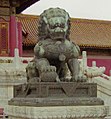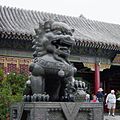Chinese guardian lions
- Fu dog redirects here. It can also refer to a breed of dog called Pekingese. See American Dragon: Jake Long for the character Fu Dog.
Guardian lions, also called Fu Dogs or Foo Dogs, and called Shi (獅) in Chinese or Ra shi da, are powerful mythic protectors that have traditionally stood in front of Chinese imperial palaces, temples, emperors' tombs, government offices, and the homes of government officials and the wealthy from the Han Dynasty (206 BC-220 AD), until the end of the empire in 1911. Imperial guardian lions are still common decorative and symbolic elements at the entrances to restaurants, hotels, and other structures.
The lions are traditionally carved from decorative stone such as marble and granite or cast in bronze or iron. Because of the high cost of these materials and the labor required to produce them, private use of Imperial guardian lions was traditionally reserved for wealthy or elite families. Indeed, a traditional symbol of a family's wealth or social status was the placement of Imperial guardian lions in front of the family home. However, in modern times less expensive lions, mass produced in concrete and resin, have become available and their use therefore no longer restricted to the elite.
The lions are generally present in pairs, with the male on the right and the female on the left. The male lion has his right paw on a globe, which represents his "feeling the pulse of the earth." The female is essentially identical, but has a single cub under her left paw. Symbolically, the male fu dog guards the structure, while the female protects those dwelling inside. Sometimes the male has his mouth open and the female closed. This symbolizes the enunciation of the sacred word "om." Other styles have both lions with a single large pearl in each of their partially opened mouths. The pearl is carved so that it can roll about in the lion's mouth but sized just large enough so that it can never be removed.
Interestingly, the lion is not indigenous to China. When Buddhist travelers brought stories about lions to China, Chinese sculptors modeled statues of lions after the travelers' descriptions--and after native dogs, since no one in China had seen a lion with his or her own eyes. The mythic version of the animal was originally introduced to Han China as the Buddhist protector of dharma. Gradually they were transformed into guardians of the Imperial dharma, and some Qing realizations of them came to look more like the dogs of Fo. (Compare the Chow Chow, Pekingese, Shi Tzu breeds.) These beasts have been found in art as early as 208 BC. In the Qing dynasty (1644-1911), the ruling Manchu derived their name from the Manjushri Buddha, who rides on a lion.
The beast is sometimes associated with feng shui or Buddhism. Fu means 'happiness' in Chinese. In China, they are known as Rui Shi (瑞獅).
There are various styles of imperial guardian lions reflecting influences from different time periods, imperial dynasties, and regions of China. These styles vary in there artistic detail and adornment as well as in the depiction of the lions from fierce to serene.
Image gallery
-
A stone shi
-
Male lion guard of the Ming Dynasty period at the Forbidden City
-
Female guardian lion with her cub at the Summer Palace, Beijing- late Qing Dynasty, but in the Ming style
-
Cub Detail
-
Standing lion at the Ming Dynasty Tombs Sacred Walk
-
Imperial guardian lion outside Ngee Ann City in Singapore
In the above gallery, note that the standing lion (a northern style nian) is wearing ornaments similar to those seen at the top of the article but does not have the shin armor.
See also
- Door god
- Lion dance, another use of lion imagery in costume and motion.
- Nian to compare with a similar but horned (unicorn) mythical beast
- Pixiu to compare with a similar but winged mythical beast
- Koma-inu to compare its use in Japanese culture
- Chinese mythology
External links
- World heritage immersive panorama In this immersive panorama from the Imperial Palace Museum, Beijing, your viewpoint will be near a large bronze lion, the female whose male counterpart's image is in the gallery above, at the Gate of Supreme Harmony.
- A commercial webpage with some pictures of Fu Dogs
- A webpage with pictures of a variety of Chinese stone lions.
- A commercial webpage with some pictures of Fu Dogs





